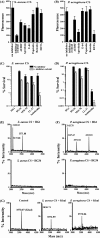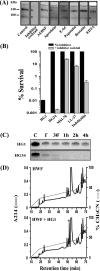Antimicrobial activity of a halocidin-derived peptide resistant to attacks by proteases
- PMID: 20385874
- PMCID: PMC2897289
- DOI: 10.1128/AAC.01790-09
Antimicrobial activity of a halocidin-derived peptide resistant to attacks by proteases
Abstract
Cationic antimicrobial peptides (AMPs) have attracted a great deal of interest as a promising candidate for a novel class of antibiotics that might effectively treat recalcitrant infections caused by a variety of microbes that are resistant to currently available drugs. However, the AMPs are inherently limited in that they are inevitably susceptible to attacks by proteases generated by human and pathogenic microbes; this vulnerability severely hinders their pharmaceutical use in human therapeutic protocols. In this study, we report that a halocidin-derived AMP, designated HG1, was found to be resistant to proteolytic degradation. As a result of its unique structural features, HG1 proved capable of preserving its antimicrobial activity after incubation with trypsin, chymotrypsin, and human matrix metalloprotease 7 (MMP-7). Additionally, HG1 was observed to exhibit profound antimicrobial activity in the presence of fluid from human skin wounds or proteins extracted from the culture supernatants of Staphylococcus aureus and Pseudomonas aeruginosa. Greater understanding of the structural motifs of HG1 required for its protease resistance might provide feasible ways to solve the problems intrinsic to the development of an AMP-based antibiotic.
Figures






Similar articles
-
Haloganan: a novel antimicrobial peptide for treatmentof wound infections.Peptides. 2014 Dec;62:137-43. doi: 10.1016/j.peptides.2014.09.025. Peptides. 2014. PMID: 25445605
-
In silico design of polycationic antimicrobial peptides active against Pseudomonas aeruginosa and Staphylococcus aureus.Antonie Van Leeuwenhoek. 2018 Oct;111(10):1871-1882. doi: 10.1007/s10482-018-1080-2. Epub 2018 Apr 6. Antonie Van Leeuwenhoek. 2018. PMID: 29626331
-
Very Short and Stable Lactoferricin-Derived Antimicrobial Peptides: Design Principles and Potential Uses.Acc Chem Res. 2019 Mar 19;52(3):749-759. doi: 10.1021/acs.accounts.8b00624. Epub 2019 Mar 4. Acc Chem Res. 2019. PMID: 30829472
-
Antimicrobial peptides: the ancient arm of the human immune system.Virulence. 2010 Sep-Oct;1(5):440-64. doi: 10.4161/viru.1.5.12983. Virulence. 2010. PMID: 21178486 Review.
-
Antimicrobial resistance of ocular microbes and the role of antimicrobial peptides.Clin Exp Optom. 2021 Apr;104(3):295-307. doi: 10.1111/cxo.13125. Epub 2021 Mar 24. Clin Exp Optom. 2021. PMID: 32924208 Review.
Cited by
-
Therapeutic efficacy of halocidin-derived peptide HG1 in a mouse model of surgical wound infection with methicillin-resistant Staphylococcus aureus.Antimicrob Agents Chemother. 2011 Mar;55(3):1296-9. doi: 10.1128/AAC.00948-10. Epub 2011 Jan 10. Antimicrob Agents Chemother. 2011. PMID: 21220538 Free PMC article.
-
Mechanistic Landscape of Membrane-Permeabilizing Peptides.Chem Rev. 2019 May 8;119(9):6040-6085. doi: 10.1021/acs.chemrev.8b00520. Epub 2019 Jan 9. Chem Rev. 2019. PMID: 30624911 Free PMC article. Review.
-
Antimicrobial properties of distinctin in an experimental model of MRSA-infected wounds.Eur J Clin Microbiol Infect Dis. 2012 Nov;31(11):3047-55. doi: 10.1007/s10096-012-1663-1. Epub 2012 Jun 23. Eur J Clin Microbiol Infect Dis. 2012. PMID: 22729599
-
Multiple roles of ribosomal antimicrobial peptides in tackling global antimicrobial resistance.R Soc Open Sci. 2022 Jan 26;9(1):211583. doi: 10.1098/rsos.211583. eCollection 2022 Jan. R Soc Open Sci. 2022. PMID: 35116161 Free PMC article.
-
Antimicrobial Susceptibility Testing of Antimicrobial Peptides to Better Predict Efficacy.Front Cell Infect Microbiol. 2020 Jul 7;10:326. doi: 10.3389/fcimb.2020.00326. eCollection 2020. Front Cell Infect Microbiol. 2020. PMID: 32733816 Free PMC article. Review.
References
-
- Batista, C. V., A. Scaloni, D. J. Rigden, L. R. Silva, A. Rodrigues Romero, R. Dukor, A. Sebben, F. Talamo, and C. Bloch. 2001. A novel heterodimeric antimicrobial peptide from the tree-frog Phyllomedusa distincta. FEBS Lett. 494:85-89. - PubMed
-
- Brewer, D., and G. Lajoie. 2002. Structure-based design of potent histatin analogues. Biochemistry 41:5526-5536. - PubMed
-
- Campopiano, D. J., D. J. Clarke, N. C. Polfer, P. E. Barran, R. J. Langley, J. R. Govan, A. Maxwell, and J. R. Dorin. 2004. Structure-activity relationships in defensin dimers: a novel link between beta-defensin tertiary structure and antimicrobial activity. J. Biol. Chem. 279:48671-48679. - PubMed
-
- Clinical and Laboratory Standards Institute. 2006. Methods for dilution antimicrobial susceptibility tests for bacteria that grow aerobically, 7th ed. Approved standard M7-A7. Clinical and Laboratory Standards Institute, Wayne, PA.
-
- Dalla Serra, M., O. Cirioni, R. M. Vitale, G. Renzone, M. Coraiola, A. Giacometti, C. Potrich, E. Baroni, G. Guella, M. Sanseverino, S. De Luca, G. Scalise, P. Amodeo, and A. Scaloni. 2008. Structural features of distinctin affecting peptide biological and biochemical properties. Biochemistry 47:7888-7899. - PubMed
Publication types
MeSH terms
Substances
LinkOut - more resources
Full Text Sources
Other Literature Sources
Molecular Biology Databases
Research Materials

